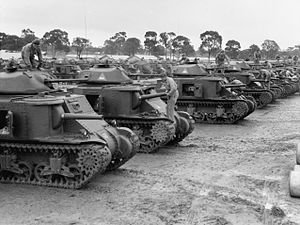
The Australian Army has used tanks from after the First World War, through the interwar period, the Second World War, the Cold War and to the present day. Throughout this period the Army has primarily been a light infantry force, with its tanks mainly being used in the direct support role. The Australian Army's tanks have seen combat during the Second World War and the Vietnam War, where they proved successful despite some of the designs employed being considered obsolete. The first Australian tanks were a small number of British medium and light tanks which were operated mainly for training purposes during the 1920s and 1930s.
The outbreak of the Second World War in 1939 led to a significant expansion of Australia's armoured force. From 1942 large numbers of American light and medium tanks were delivered to Australia, along with British Matilda IIs. In addition, a small number of Australian-designed Sentinel tanks were delivered to the Army during 1942 and 1943, but the type was never issued to combat units. Three armoured divisions capable of independent operations were formed during the Second World War, but none were deployed outside Australia. Many individual units later fought against the Japanese in the Pacific, although only in regimental strength.
With few modern tanks at the time of the Korean War, the Australian Army had to rely on British and US tank support. During the 1950s the Army standardised on the British Centurion tank, which saw action in Vietnam and remained in service until it was replaced with the German Leopard 1 in the mid-1970s. After an internal debate on whether the Army should continue to operate tanks as part of its force structure, the Australian Government replaced the Leopards with a small fleet of American M1A1 Abrams tanks in 2007, which are now the Army's only tanks. In addition to these types, the Army has operated small numbers of other tank designs for training and evaluation purposes.